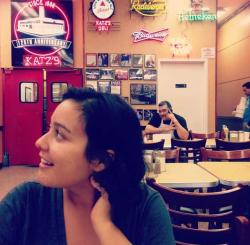“What is sight anyway?” asks Angela Charles, a visual artist who has been gradually losing her vision. In What Are You Looking At?, Liberty Smith’s clever portrait documentary, Charles walks us through her process with charming humor, embracing her new reality while continuing to create art.
While articulated around artist Charles, the film is not just a portrait documentary about her art and her journey. Instead, Smith expands the scope of her film through its intelligent uses of narration and audio description as integral elements of her storytelling, thus making the film more emotionally engaging. The different narrators, their different perspectives, and Angela’s natural charisma prevent the film from ever becoming static or repetitive.
Editing the film herself, Smith builds an emotionally effective narrative, alternating between archival footage of eye tests and interviews with Charles, as she shares her own experiences from when she was diagnosed. The eye charts, used as intertitles, work to keep the audience active and involved, while the audio description allows us to see things in a different way. Expertly combining these elements with Charles’ testimonies, the film maintains a lightness throughout, successfully letting us experience art through Angela’s eyes, thanks to her evocative and precise explanations.

Angela Charles in her art studio
Charles’ positivity and resilience shine through the screen, making her incredibly inspiring. When she touches on the challenges she had to adapt to, Smith frames her carefully with shots that convey how she navigates her new environment. Her playfulness and sense of humor are also very much present in the tone of the film, as not only is her story fascinating and empowering, her fun on-camera presence makes her a truly engaging participant
As Charles says in the film, most people’s experience with audio description is looking up how to turn it off. Smith’s decision to use it as a storytelling tool is not only incredibly smart, but also feels like an original way of crafting the story. Hearing Charles’ firsthand account of how important it is to her and listening to the narrator explain how he chooses what to say for his audience effectively places us in her shoes. This approach aligns perfectly with the film’s goal of encouraging us to look at art in a different way.
What Are You Looking At? made its way around the festival circuit with notable stops at Hot Docs, DOC NYC, Ann Arbor and Hot Springs, ahead of its online debut as a Vimeo Staff Pick.

 Céline Roustan
Céline Roustan